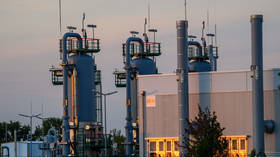EU says its gas reserves are ready for winter. But there's a catch
Despite having ample reserves, member states appear to have little control over the bloc’s hoarded fuel

As the European Union has been struggling to prepare for a possible total suspension of Russian energy supplies ahead of the winter season, gas storage has emerged as a national security priority.
The bloc has set mandatory levels to restock reserves in order to meet high demand. RT examines how much authority member states actually have over those stocks in the event of an emergency.
- How full are EU stores right now?
EU countries have already reached the target of having their natural gas storage sites 80% full by November. Levels stood around 94% this week, in line with their average over the 2017-2021 period, according to data from Gas Infrastructure Europe (GIE). The bloc’s biggest economy, Germany, had its stores 93% full – close to Berlin’s goal of 95% full by November. - Where are the bloc’s key storage facilities located?
Storage capacity in the EU is unevenly distributed with large facilities in France, Germany, Italy and the Netherlands. Germany is home to the largest stores in the bloc. The EU has capacity to store more than 117 billion cubic meters (bcm) of natural gas, or roughly a fifth of its annual consumption, according to GIE. - Who has control over the stored gas?
There is a lack of transparent data on who controls the stockpile, but it turns out that national governments have little to no control over the supplies. Only about 10% of the gas in storage facilities from Italy to the Netherlands is under the direct control of public officials through national strategic reserves, according to data compiled by Bloomberg. The rest is in the hands of international trading companies, like Glencore and Vitol, energy utilities and industrial groups. Those companies are free to sell to the highest bidder, even if it’s in another country, while their main interest is maximizing their profit margins. - How is the fuel being distributed?
The bloc’s gas network is supposed to work by allowing supplies to flow between markets. As long as there’s enough fuel in the system, it should balance out. However, in an emergency, governments can order a required amount of gas from those reserves. Richer countries can outbid poorer countries for gas supplies. That could leave neighboring states facing shortages. - Is there a solution?
The creation and procurement of gas and storage sites for government-controlled strategic reserves is among the proposals for the bloc’s energy security in the long term. That would mean a centralized European platform where member states can jointly buy gas, and use this to create strategic reserves. In other words, countries would share their gas storage with one another. However, the process of setting up such a platform could take years, experts warn. - Could the gas-sharing strategy work?
The gas-sharing pacts between member states are part of a larger EU mechanism for energy emergency situations. They guarantee that one country will supply the other if they don’t have enough gas to provide for the needs of households and social services, which enjoy special protection under EU law. Joint purchases of natural gas by member states could help avoid competition within the bloc and further rises in prices, the European Commission says. However, with the worsening energy crisis across the union, some nations have been refraining from engaging in any such solidarity deals. - What’s in store for the EU?
The bloc’s gas network hasn’t operated under a scenario like the current crisis, experts say, noting that much will depend on the weather. According to consultancy Wood Mackenzie, in the event of a cold winter, inventories could sink below 10% by the end of March, which could set off a renewed scramble for supplies ahead of next winter. Some traders and analysts have warned that the real test will be refilling stores next year without Russian gas supplies and as the EU target rises to 90% by November 1.
For more stories on economy & finance visit RT's business section
You can share this story on social media:












